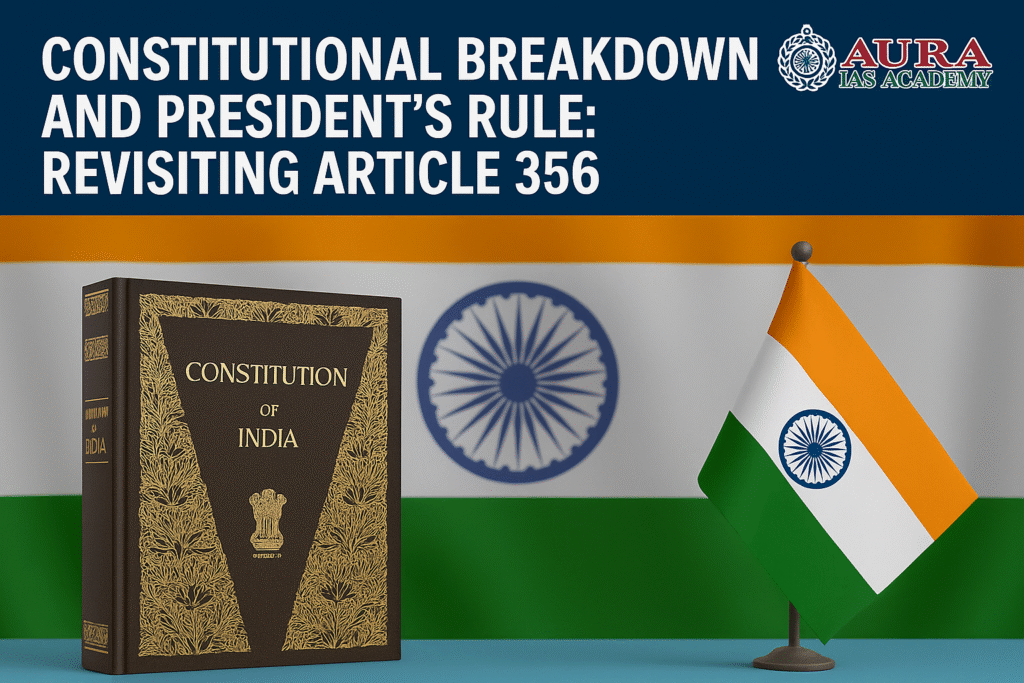Constitutional Breakdown and President’s Rule: Revisiting Article 356

In September 2025, debates over the misuse of Article 356 resurfaced after reports of political instability in a few Indian states.
The President’s Rule, often invoked in times of constitutional breakdown, remains one of the most discussed and controversial provisions in the Indian Constitution.
For UPSC aspirants, this topic is significant for GS Paper 2 (Polity and Governance) and GS Paper 1 (Indian Constitution – Historical Evolution and Federalism).
Background: Understanding Article 356
Article 356 empowers the President of India to assume control of a state’s governance when the constitutional machinery fails.
It was inspired by the Government of India Act, 1935, which allowed the British Governor to take over provincial administration.
The provision was included in the Constitution to ensure national unity, but over time, it has been both a safeguard and a political weapon.
Constitutional Provisions
📘 Article 355: Duty of the Union to protect States against external aggression or internal disturbance.
📜 Article 356: Allows the President to impose central rule when the state government cannot function in accordance with the Constitution.
🕰️ Duration:
Initially valid for 6 months, extendable up to 3 years with Parliamentary approval.
Requires both Lok Sabha and Rajya Sabha approval within two months.
Grounds for Imposing President’s Rule
⚠️ 1. Breakdown of Constitutional Machinery:
When the Governor reports that the state government cannot function as per constitutional norms.
⚖️ 2. Loss of Majority:
If no party commands a majority and no alternative government can be formed.
🛡️ 3. Failure to Maintain Law and Order:
In cases of severe internal disturbance or violence disrupting governance.
📉 4. Corruption or Maladministration:
In rare cases, where the administration’s functioning is against public interest.
Impact of President’s Rule
🔹 Administrative Consequences:
The Governor assumes executive powers on behalf of the President.
🔹 Legislative Implications:
The State Legislative Assembly may be either suspended or dissolved.
🔹 Financial Control:
State finances come under the direct control of the Union Government.
🔹 Political Impact:
Often leads to temporary centralization of power and political instability at the regional level.
Judicial Review and Safeguards
⚖️ The Supreme Court in S.R. Bommai vs Union of India (1994) restricted arbitrary use of Article 356 by setting key principles:
The President’s decision is subject to judicial review.
The Governor’s report must be based on objective material evidence.
Floor test is the ultimate method to determine majority support.
Repeated misuse of Article 356 would violate the federal structure, a part of the Basic Structure Doctrine.
Instances of President’s Rule
📊 Since 1950, Article 356 has been invoked over 125 times.
Frequent use in early decades: Used extensively during political turbulence in states.
Post-Bommai era: Marked decline due to judicial oversight.
Recent examples: Maharashtra (2019), Jammu & Kashmir (2018), and others during transitions of power.
Criticism and Reforms
🚫 Criticism:
Misused by the ruling party at the Centre to dismiss state governments.
Weakens the spirit of federalism and democratic representation.
✅ Reforms Suggested:
Strengthen the office of the Governor with accountability mechanisms.
Mandate judicial pre-clearance before imposing President’s Rule.
Promote political consensus for resolving inter-governmental crises.
UPSC Relevance
GS Paper 2:
Indian Constitution – Federal Structure, Centre-State Relations
Role of the Governor and President’s Rule
GS Paper 1:
Evolution of Indian Federalism
💡 Example UPSC Question:
“Critically examine the constitutional validity and political implications of President’s Rule under Article 356 in India.”
Way Forward
India’s democracy thrives on cooperative federalism.
While Article 356 remains necessary for constitutional emergencies, it must be exercised with transparency, restraint, and judicial oversight.
Strengthening institutional checks and promoting political dialogue are vital to preserving the balance between Union authority and State autonomy.
Conclusion
President’s Rule is a constitutional emergency tool — not a political instrument.
The evolution of Article 356, from misuse to judicial regulation, reflects India’s maturing democracy.
Going forward, ensuring ethical governance and federal harmony will uphold the constitutional promise of “Unity in Diversity.”
📘 For UPSC Aspirants – Recommended Reading
Aura IAS GS Paper 2 PYQs (2013–2025)
✔️ Constitutional Provisions, Governance, Federalism & Judiciary
🛒 Explore Here: 👉 https://auraias.in/shop



